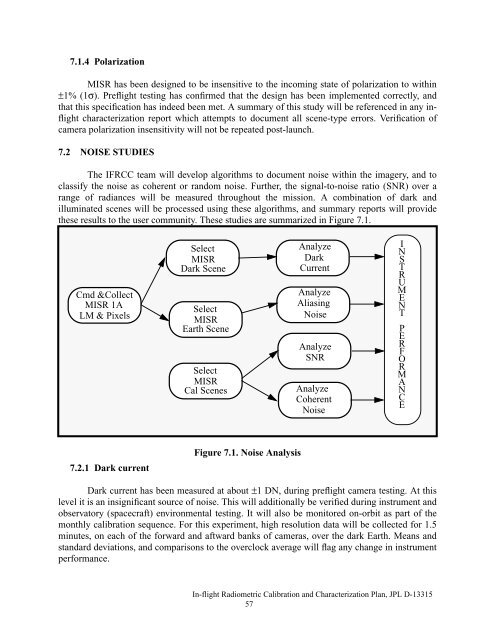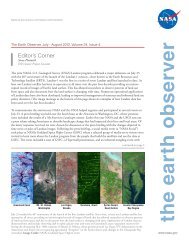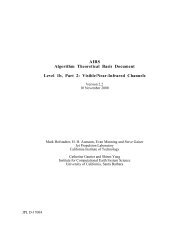MISR: In-Flight Radiometric Calibration and Characterization Plan
MISR: In-Flight Radiometric Calibration and Characterization Plan
MISR: In-Flight Radiometric Calibration and Characterization Plan
You also want an ePaper? Increase the reach of your titles
YUMPU automatically turns print PDFs into web optimized ePapers that Google loves.
7.1.4 Polarization<strong>MISR</strong> has been designed to be insensitive to the incoming state of polarization to within±1% (1σ). Preflight testing has confirmed that the design has been implemented correctly, <strong>and</strong>that this specification has indeed been met. A summary of this study will be referenced in any inflightcharacterization report which attempts to document all scene-type errors. Verification ofcamera polarization insensitivity will not be repeated post-launch.7.2 NOISE STUDIESThe IFRCC team will develop algorithms to document noise within the imagery, <strong>and</strong> toclassify the noise as coherent or r<strong>and</strong>om noise. Further, the signal-to-noise ratio (SNR) over arange of radiances will be measured throughout the mission. A combination of dark <strong>and</strong>illuminated scenes will be processed using these algorithms, <strong>and</strong> summary reports will providethese results to the user community. These studies are summarized in Figure 7.1.Select<strong>MISR</strong>Dark SceneAnalyzeDarkCurrentIN STRUCmd &Collect<strong>MISR</strong> 1ALM & PixelsSelect<strong>MISR</strong>Earth SceneAnalyzeAliasingNoiseM ENTP ERFORMANCESelect<strong>MISR</strong>Cal ScenesAnalyzeSNRAnalyzeCoherentNoise7.2.1 Dark currentFigure 7.1. Noise AnalysisDark current has been measured at about ±1 DN, during preflight camera testing. At thislevel it is an insignificant source of noise. This will additionally be verified during instrument <strong>and</strong>observatory (spacecraft) environmental testing. It will also be monitored on-orbit as part of themonthly calibration sequence. For this experiment, high resolution data will be collected for 1.5minutes, on each of the forward <strong>and</strong> aftward banks of cameras, over the dark Earth. Means <strong>and</strong>st<strong>and</strong>ard deviations, <strong>and</strong> comparisons to the overclock average will flag any change in instrumentperformance.<strong>In</strong>-flight <strong>Radiometric</strong> <strong>Calibration</strong> <strong>and</strong> <strong>Characterization</strong> <strong>Plan</strong>, JPL D-1331557







